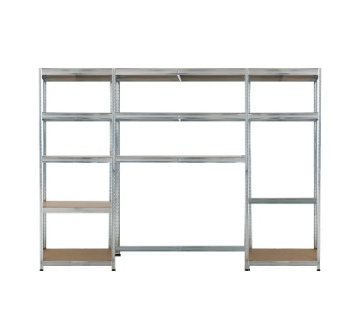Maximizing Warehouse Efficiency with Modern Storage Solutions
The backbone of any successful warehouse operation lies in its storage infrastructure. Storage racks have evolved from simple shelving units to sophisticated systems that can transform warehouse productivity and space utilization. In today's fast-paced logistics environment, choosing the right storage racks can make the difference between operational excellence and costly inefficiencies.
Modern warehouses face increasing pressure to store more inventory while maintaining quick access and organized systems. The key to meeting these challenges lies in selecting storage racks that align with specific business needs, space constraints, and handling requirements. Let's explore the top industrial storage solutions that are revolutionizing warehouse management.
Selective Pallet Racking Systems
Features and Applications
Selective pallet racking stands as the most widely used storage system in warehouses worldwide. These versatile storage racks offer direct access to every pallet position, making them ideal for operations handling diverse SKUs. The system consists of upright frames and horizontal beams that can be easily adjusted to accommodate different pallet sizes and weights.
The beauty of selective racking lies in its flexibility. Warehouse managers can modify the configuration as needs change, whether expanding vertically or horizontally. The system supports various load sizes and can be installed in both single-deep and double-deep arrangements, maximizing storage density while maintaining accessibility.
Installation and Maintenance Considerations
While selective pallet racks offer straightforward installation, proper setup is crucial for safety and efficiency. Professional installation ensures correct beam levels, appropriate floor anchoring, and proper weight distribution. Regular maintenance inspections help identify potential issues like damaged components or misaligned beams before they become safety hazards.
To maximize the lifespan of selective storage racks, implement a routine inspection schedule and train forklift operators in proper handling techniques. This proactive approach prevents damage and ensures optimal performance throughout the system's lifecycle.
Drive-In and Drive-Through Racking
High-Density Storage Benefits
Drive-in and drive-through racking systems represent the pinnacle of high-density storage solutions. These storage racks eliminate traditional aisles, allowing forklifts to drive directly into the rack structure. This design can increase storage capacity by up to 75% compared to selective racking, making it ideal for warehouses handling large quantities of similar products.
The key difference between drive-in and drive-through systems lies in their access points. Drive-in racks offer entry from one side, while drive-through systems allow access from both ends. This flexibility makes them particularly suitable for cold storage facilities and applications where space optimization is paramount.
Operational Efficiency Analysis
When implementing drive-in or drive-through storage racks, careful consideration must be given to operational flow. These systems work best with LIFO (Last-In-First-Out) or FIFO (First-In-First-Out) inventory management strategies, depending on the chosen configuration. Proper forklift training becomes essential, as operators must navigate within the rack structure with precision.
While these systems excel in storage density, they require careful product selection and load management. Items stored should be uniform in size and durable enough to withstand potential contact during handling. Regular maintenance of guide rails and support components ensures smooth operations and prevents costly damage.
Cantilever Racking Solutions
Design and Versatility
Cantilever racking systems shine in storing long, awkward items that don't fit traditional pallet racking. These storage racks feature vertical columns with horizontal arms extending outward, creating flexible storage space for items like lumber, pipes, and metal profiles. The absence of front columns allows unrestricted access to stored materials.
Modern cantilever systems offer adjustable arms that can be repositioned to accommodate changing inventory needs. Single and double-sided configurations provide options for both wall-mounted and freestanding installations, maximizing warehouse space utilization.
Material Handling Optimization
The success of cantilever storage racks depends largely on proper load distribution and handling procedures. Each arm must be rated for specific weight capacities, and loads should be evenly distributed to prevent system stress. Implementation of proper material handling equipment, such as side loaders or specialized forklifts, ensures efficient and safe operations.
Regular inspections of arm connections and base plates help maintain system integrity. Additionally, clear marking of weight capacities and proper training of handling personnel contribute to safe and efficient operations.
Push-Back Racking Systems
Dynamic Storage Capabilities
Push-back racking combines the benefits of high-density storage with selective accessibility. These storage racks utilize inclined rails and nested carts to allow multiple pallets to be stored within a single lane. When retrieving items, gravity brings the next pallet forward automatically, maximizing picking efficiency.
The system can typically accommodate between two to six pallets deep, offering significant storage density while maintaining good selectivity. This makes push-back racking ideal for warehouses handling multiple SKUs with medium to high turnover rates.
Implementation Strategies
Successful implementation of push-back storage racks requires careful planning and consideration of product characteristics. The system works best with stable, similarly sized pallets and products that can withstand some movement. Proper training ensures operators understand the loading and unloading sequences to prevent system damage.
Regular maintenance of cart mechanisms and rails is essential for smooth operation. Implementing a robust inventory management system helps track pallet positions and optimize storage utilization within the push-back system.
Flow Rack Systems
Automated Flow Dynamics
Flow rack systems represent the cutting edge of dynamic storage solutions. These storage racks use gravity-fed rollers or wheels to move products from loading to picking faces automatically. The system ensures perfect FIFO rotation and can significantly reduce picking times and labor costs.
Available in both pallet and carton sizes, flow racks can be configured for various applications, from full pallet storage to piece-picking operations. The automated movement of products eliminates the need for repeated handling, reducing the risk of damage and improving workplace safety.
Performance Optimization
To maximize the benefits of flow rack systems, careful attention must be paid to product characteristics and flow rates. Proper roller spacing and brake mechanisms ensure controlled product movement and prevent damage. Regular cleaning and maintenance of roller tracks keep the system operating at peak efficiency.
Integration with warehouse management systems can further enhance performance by optimizing picking routes and maintaining accurate inventory counts. The system's ability to automatically replenish picking faces reduces labor requirements and minimizes stock-outs.
Frequently Asked Questions
How do I choose the right storage rack system for my warehouse?
Select storage racks based on factors including available space, inventory characteristics, turnover rates, and handling equipment. Consider product dimensions, weight, and quantity alongside operational requirements like accessibility and picking frequency. Consulting with storage solutions experts can help determine the optimal system for your specific needs.
What safety considerations are essential for storage rack installations?
Key safety considerations include proper installation by qualified professionals, regular maintenance inspections, clear posting of load capacities, adequate aisle spacing, and proper anchor bolt installation. Employee training on safe operation procedures and implementation of protective measures like column guards are also crucial.
How often should storage racks be inspected and maintained?
Conduct visual inspections weekly for obvious damage, perform detailed quarterly inspections of all components, and schedule annual professional assessments. Immediate inspection is necessary following any incident involving rack contact. Document all inspections and promptly address any identified issues to maintain system safety and efficiency.

 EN
EN
 AR
AR
 BG
BG
 HR
HR
 CS
CS
 DA
DA
 NL
NL
 FI
FI
 FR
FR
 DE
DE
 HI
HI
 IT
IT
 JA
JA
 KO
KO
 NO
NO
 PL
PL
 PT
PT
 RO
RO
 RU
RU
 ES
ES
 SV
SV
 TL
TL
 IW
IW
 ID
ID
 LV
LV
 LT
LT
 SR
SR
 SK
SK
 VI
VI
 ET
ET
 HU
HU
 TH
TH
 TR
TR
 AF
AF
 MS
MS
 LO
LO
 LA
LA
 MR
MR


